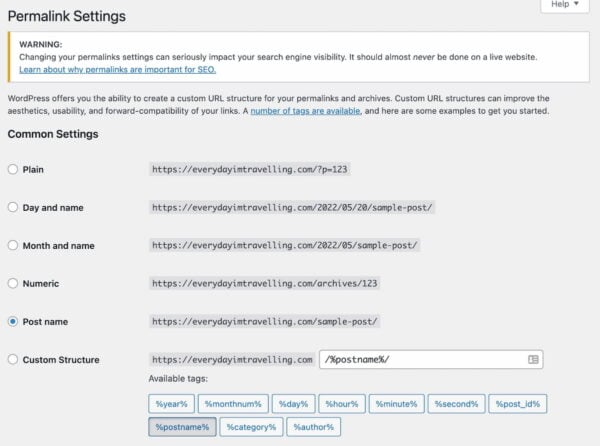It’s worth spending some time clicking through all of the sections in the WordPress Settings menu, as many of the options there can impact the SEO of your WordPress site.
In particular, it’s worth double-checking your visibility settings in Settings → Reading to ensure that you’re not accidentally preventing search engines from indexing your website. That’d hurt your visibility and your WordPress SEO!
You should also ensure that your Writing and Reading settings are all set correctly; these control your default categories and what should be displayed on your homepage. Don’t forget to give your site a strong tagline in Settings → General!
1.3. Pick the right permalink structure
Your permalink settings define what format your page and post URLs will take, which can significantly impact WordPress SEO. So if you’re creating a new site, one of the first things you should do is change your permalink settings, which you can find in Settings → Permalinks.
If you don’t change your settings from the default, all of your pages and posts will have URLs that look like example.com/?p=123. While this is perfectly okay, it’s not particularly nice, and it might impact how users and search engines perceive the quality and relevance of your pages.
Changing the permalink structure alters your website’s URLs, components, ordering, and structure. Therefore, selecting the correct format when setting up your website is essential, as changing it later can cause SEO issues.
We usually recommend that people use a structure that creates URLs that look like example.com/post-name/, or example.com/category/post-name/,
depending on how much importance they anticipate placing on
categorizing their content. Choosing either of these options will be
perfectly suitable for most WordPress sites.
For the first option, you can just change the permalink setting to /%postname%/, like so:

To include the category, you can select “Custom Structure” and change the value to /%category%/%postname%/.
If you previously had ?p=<postid> as your permalink, WordPress will take care of all the redirects for you. This is also true if you change from /%postname%/ to /%category%/%postname%/.
If you have an established site and change from any other permalink structure, you might want to consult our article on changing your WordPress permalink structure and the tool you’ll find.
1.3.1. Choose WWW or non-WWW
It would help if you thought about what you want your site to show as www.example.com, or simply example.com. Make sure that in your general settings, in Settings → General, the version you want to show up is properly reflected:

From an SEO perspective, there’s little difference either way. Additionally, most hosting and server setups will automatically redirect requests for the ‘wrong’ version to your selected version. That makes this primarily a branding consideration — which approach feels best for your site?
There’s not a massive amount of difference from a technical perspective, either. Some setups might have minor headaches if they omit the ‘www’ component, but these are increasingly rare.
No comments:
Post a Comment